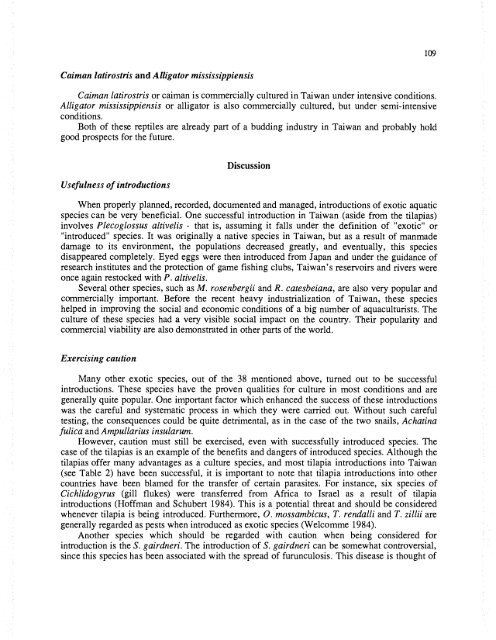Exotic Aquatic Organisms - International Development Research ...
Exotic Aquatic Organisms - International Development Research ...
Exotic Aquatic Organisms - International Development Research ...
Create successful ePaper yourself
Turn your PDF publications into a flip-book with our unique Google optimized e-Paper software.
Caiman latirostris and Alligator mississippiensis<br />
Caiman latirostris or caiman is commercially cultured in Taiwan under intensive conditions.<br />
Alligator mississippiensis or alligator is also commercially cultured, but under semi-intensive<br />
conditions.<br />
Both of these reptiles are already part of a budding industry in Taiwan and probably hold<br />
good prospects for the future.<br />
Usefulness of introductions<br />
Discussion<br />
When properly planned, recorded, documented and managed, introductions of exotic aquatic<br />
species can be very beneficial. One successful introduction in Taiwan (aside from the tilapias)<br />
involves Plecoglossus altivelis - that is, assuming it falls under the definition of "exotic" or<br />
"introduced" species. It was originally a native species in Taiwan, but as a result of manmade<br />
damage to its environment, the populations decreased greatly, and eventually, this species<br />
disappeared completely. Eyed eggs were then introduced from Japan and under the guidance of<br />
research institutes and the protection of game fishing clubs, Taiwan's reservoirs and rivers were<br />
once again restocked with P. altivelis.<br />
Several other species, such as M. rosenbergii and R. catesbeiana, are also very popular and<br />
commercially important. Before the recent heavy industrialization of Taiwan, these species<br />
helped in improving the social and economic conditions of a big number of aquaculturists. The<br />
culture of these species had a very visible social impact on the country. Their popularity and<br />
commercial viability are also demonstrated in other parts of the world.<br />
Exercising caution<br />
Many other exotic species, out of the 38 mentioned above, turned out to be successful<br />
introductions. These species have the proven qualities for culture in most conditions and are<br />
generally quite popular. One important factor which enhanced the success of these introductions<br />
was the careful and systematic process in which they were carried out. Without such careful<br />
testing, the consequences could be quite detrimental, as in the case of the two snails, Achatina<br />
fulica and Ampullarius insularum.<br />
However, caution must still be exercised, even with successfully introduced species. The<br />
case of the tilapias is an example of the benefits and dangers of introduced species. Although the<br />
tilapias offer many advantages as a culture species, and most tilapia introductions into Taiwan<br />
(see Table 2) have been successful, it is important to note that tilapia introductions into other<br />
countries have been blamed for the transfer of certain parasites. For instance, six species of<br />
Cichlidogyrus (gill flukes) were transferred from Africa to Israel as a result of tilapia<br />
introductions (Hoffman and Schubert 1984). This is a potential threat and should be considered<br />
whenever tilapia is being introduced. Furthermore, 0. mossambicus, T. rendalli and T. zulu are<br />
generally regarded as pests when introduced as exotic species (Welcomme 1984).<br />
Another species which should be regarded with caution when being considered for<br />
introduction is the S. gairdneri. The introduction of S. gairdneri can be somewhat controversial,<br />
since this species has been associated with the spread of furunculosis. This disease is thought of<br />
109

















